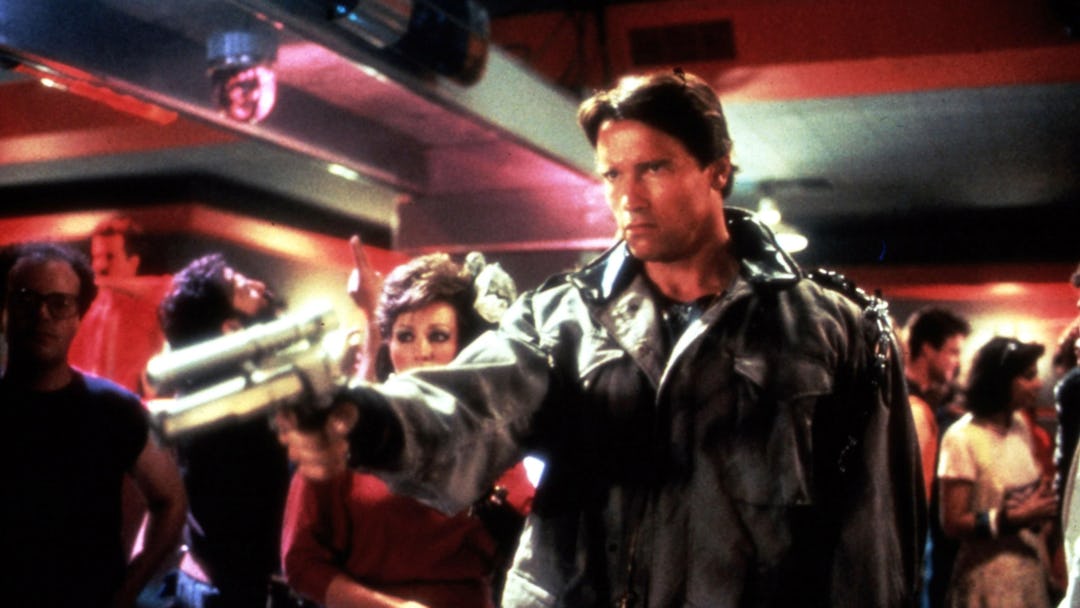Today, the ridiculously titled fifth film in the Terminator franchise, Terminator: Genysis, hits theaters. The notices thus far have been less than enthusiastic (Paramount elected not to invite us to see it in advance, so I can’t tell you if they’re right), with many pinpointing the picture’s decision to revisit and revise the events of the original 1984 film as a particular sticking point. But a return to that inaugural entry — which, let’s face it, is probably a better way to spend an evening anyway — serves as a reminder that this series started out as a very different kind of film, and on a far smaller scale.
When you get down to it, the 1984 Terminator is a low-budget exploitation movie. Co-writer/director James Cameron cut his teeth working for Roger Corman, devising effects on the cheap for movies like Battle Beyond the Stars — and one of the most striking things about Terminator, right there in its opening, 2029-set prologue, is how low-rent the effects and sets are. Later glimpses of the bombed-out future recall not only Escape From New York — on which Cameron was credited for his visual effects and matte work — but ripoffs like 1990: The Bronx Warriors. Scenes like those, alongside the lightning effects and laser shots (you can see, on the DVD, the duplication distress on the frames where FX were added in those analog days) betray the picture’s low budget.
That budget was a scant $6.5 million, which inflation adjusts to just shy of $15 million today — or, less than 1/10 of the Terminator: Genisys budget. And it bears the stylistic watermarks of its era; the run-and-gun cinematography, the throwback fonts, and especially the synth-and-drum-machine score make it look and feel less like the launch of a billion-dollar franchise and more like a Cannon movie that Chuck Norris somehow passed on. (There’s even a Dick Miller cameo.)
None of this is meant as a slam — in fact, much of Terminator’s greatness is due to its low-budget aesthetic and lo-fi energy. Perhaps out of necessity, Cameron’s sense of storytelling has a lean efficiency that both he and the series have long since abandoned; it runs a mere 107 minutes, and doesn’t really bother to explain what’s happening until nearly 45 minutes in. And it sports a welcome exploitation movie ruthlessness; he’s got Schwarzenegger just walking up to people’s doors and killing strangers in their homes, which is quite a contrast to the softening that began with the “I swear I will not kill anyone” business of T2 and eventually resulted in the last two Terminator films landing with PG-13 ratings. Terminator is a very hard R — some images, like Schwarzenegger coming down the police station hallway for Linda Hamilton, play like slasher horror as much as action. (Cameron later said he visualized Terminator, particularly from a business standpoint, as a “stylish horror movie.”)
Visual cues like those remind us of the era in which it was made, and much of it hasn’t aged all that well — let’s not talk about the oh-so-‘80s sex scene, with its squeezing hands close-ups and the synthesizer on “classical piano” setting, or the Friday the 13th-style, “it’s still not dead” multiple endings. But there’s nothing wrong with a movie aging; it merely creates a stark contrast, because Terminator 2 seems barely to have aged at all. And it shouldn’t — it feels, in most ways, like a modern action movie because it was the blueprint for them. The subsequent Terminator movies have followed its lead, and mostly ignored (from a stylistic standpoint, at least) the original.
Genisys reportedly bucks that trend, painstakingly replicating the feel, the sets, and even Schwarzenegger himself, circa 1984 — but at the service of an alternate-timeline narrative that seeks to reboot the entire series. And that’s a fool’s errand; a big studio sequel can’t replicate the original Terminator, because it feels so distinctively homemade, from those chintzy lightning strikes to the wonderfully Harryhausen-esque stop-motion cyborg skeleton of the climax. In scenes like that, Terminator feels like it’s handcrafted. The sequels (even, in this respect, T2) play as if they’ve been made by a committee.
The implication isn’t that a low-budget exploitation film can’t blossom and boom into a successful big-money franchise; just a few weeks ago, the metamorphosis from Mad Max to Fury Road proved that very thing. But Terminator’s ground-level aesthetic is so sharply displaced from the bloated mythology that has grown from it over the course of those four sequels, forgotten television series (with another on the way), and countless comic books, it barely seems part of the same universe. And maybe that’s why fans are so pissed at Genisys’ central premise — because it proposes to wipe out this sui generis entry, and to replace it with the same old (new) thing.
